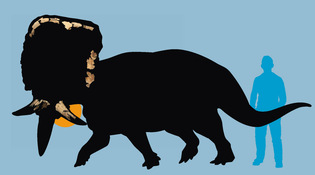 loading
loading
Cold case: dinosaur edition Photo illustration: Mark Zurolo ’01MFA. Dinosaur image: Nick Longrich.This 78-million-year-old herbivore species is still unnamed. Longrich is proposing a name based on that of the river basin where it was collected. Longrich found the fossils at the Peabody; they were collected in the 1970s. View full imageOn a recent trip, Longrich was touring dinosaur country,visiting small museums in Wyoming and Colorado near the sites where the great nineteenth-century bone hunter, Yale paleontologist O. C. Marsh, dug up much of the Peabody’s collection. But unlike Marsh, Longrich was travelling without a shovel or crew, limiting his search to the basements and back storage rooms of the natural history and geological museums and his luggage to jeans, polo shirts, and a digital camera. Laramie was the first stop. Historically, the University of Wyoming’s paleontologists had focused on mammals, not dinosaurs—which is why few of the non-mammal fragments in the collection were catalogued correctly or in much detail. As Longrich opened locked metal cabinets to peer into drawers full of specimens, he found jars and jewelry boxes of tiny, broken fossils labeled simply: Dinosaur Teeth, Lizard Jaws, Birds. Except, often, they weren’t. The box of stoppered jars of bird fossils contained no bird bones. The container of “crocodile” teeth contained Tyrannosaurus rex teeth. The jar of “lizard” teeth was full of amphibians. “It’s not even close,” Longrich said as he peered at a tiny salamander tooth from the lizard jar. When archaeologists collect new fossils, they mostly find scraps. Much more common than the complete skeletons on display at natural history museums are single teeth, toe bones, or jaws. For smaller animals, whose bones are more vulnerable to damage before they fossilize, tiny fragments may be the only fossils ever found. As a result, much of paleontology consists of piecing together information from minute differences between fragments. Most carnivore teeth are triangular in shape, but the teeth of the plant-eating Thescelosaurus are acorn-shaped in cross section. T. rex teeth have a distinct pattern of serration. Bird species are frequently identified by a shoulder bone alone. Many scientists know one area of the fauna well; they can distinguish between similar dinosaurs, say, but not lizards. Longrich has an unusual knack for shapes and patterns. He can frequently identify a species based on one of its least distinctive bones, or fit broken pieces of fossil together to form a frill or horn. He can whip up a sketch of an animal from a few fragments. He has discovered new birds and lizards as well as dinosaurs. Other scientists who have crossed paths with him say he has an unusual talent for spotting species. “I’ve had a lot of experience, and I think I’m good at it, but he impressed me,” Gauthier says. “You can’t send Nick down to New York without him coming back with ‘Look at this, I found a new one, a new lizard. Look.’ And you look at it and say, ‘Yes, we’ve never seen anything like this.’” One of Longrich’s biggest early discoveries, a new species of small dinosaur in Canada, was based on a single pelvis bone that fit in the palm of his hand. Relatives of the animal, a feathered carnivore that was an early ancestor of modern birds, had been found in China, but not in North America. After spotting the pelvis, he examined material that had been collected nearby and found more bones. “I’m kicking myself for missing these things,” says Philip Currie, a professor of dinosaur paleobiology at the University of Alberta and the president of the Society of Vertebrate Paleontology. He curated the collection where Longrich had found the bone. “It had been sitting here in our collection in Edmonton for 30 years, misidentified as a lizard.” Longrich also has a talent for visualizing how the living animals used their anatomy. Another small Canadian dinosaur he found interested him because it didn’t look like most carnivores: it had unusually short arms, each with a single claw. Longrich proposed that it ate insects, using its distinctive claws to scrape termites from rotten wood. In the case of a sheep-sized Cretaceous herbivore called Protoceratops, he noticed that some of its eye socket bones were large, like those of certain modern species, and suggested it might have been nocturnal. In recent years, Longrich has made a series of discoveries that landed him in major newspapers and magazines, along with the elite science journals that matter to his peers. He found a “ninja bird” that wielded its club-shaped wings “like nunchucks.” And named the Mojoceratops, a hippo-sized dinosaur with a heart-shaped scalloped frill. He found evidence that Tyrannosaurus rex was sometimes a cannibal. And named a dome-skulled Texas dinosaur that competed for mates by butting heads with its rivals. The PR team at Yale has suggested Longrich for Popular Science’s annual “Brilliant 10” list. Matthew Lamanna, an assistant curator at the Carnegie Museum of Natural History, hasn’t collaborated with Longrich, but says he’s been consistently impressed by his creative work. “He’ll give you a controversial idea, and my first reaction is ‘Holy crap, what the hell is this?’ But then you read his paper or listen to his presentation about it and find yourself nodding your head. He’s an out-of-the-box thinker, but in the best way. He backs up his at-first-glance-wild ideas with really rigorous research.”
|
|